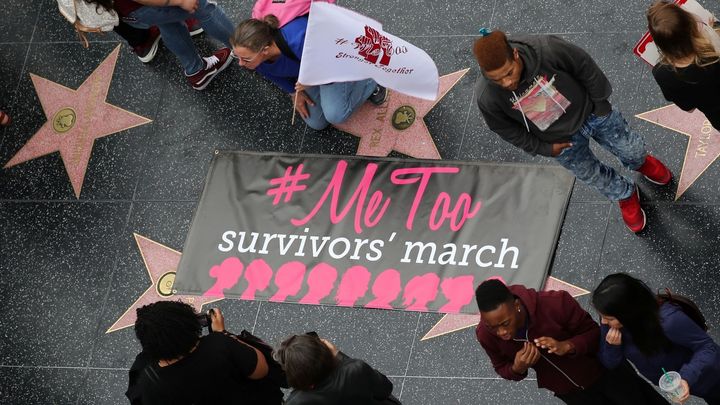
Louise Stanger is a speaker, educator, licensed clinician, social worker, certified daring way facilitator and interventionist who uses an invitational intervention approach to work with complicated mental health, substance abuse, chronic pain and process addiction clients.
Unprecedented Times
It’s not surprising that Time’s annual Person of the Year - dubbed The Silence Breakers - went to the brave women who spoke out against abuse and sparked a movement. I remember burning bras and marching in rallies in the 1960s to Helen Reddy’s “I Am Woman,” and Rosabeth Kanter writing the seminal piece in the Harvard Business Review - “Breaking the Glass Ceiling.” Those moments of protest fueled a revolution. Today, the #metoo movement, still in its infancy, has now shattered that glass and blew the lid off a culture of secrecy and shame. We’re living in unprecedented times.
Sexual misconduct, harassment, and assault in the workplace are not new to human experience. As a culture, our mores around this topic have been taboo, hence keeping it out of the center of national debate. In fact, the term sexual harassment did not exist in our lexicon until 40 years ago, when a brave Cornell University employee resigned her position due to her claim that she was wrongfully sexually harassed.
On October 8th, 2017, the New York Times released a story about a cadre of victims of sexual mistreatment raising their voices. The ripples from this bold move, or should I say cascading waves, dethroned movie mogul Harvey Weinstein and the #metoo movement blasted off at warp speed.
As an social worker who is an addiction/mental health expert, I am not only interested in how this movement started, but also why so much wrong-doing was kept under lock and key for so long. I have worked with clients and their families who experience substance abuse and mental health disorders. At the heart of these matters are silence, shame and fear, which I believe echo similar drivers of sexual abuse/harassment in the workplace. Perhaps the commonalities can teach us more about human behavior, and the ways in which we operate in the world.
How Shame Drives Behavior
My work with high wealth clients has shown me how fear and shame drive certain behaviors. No woman or man wants to openly talk about what their superior inappropriately does or tries to do to them or what they may be asked to do all in the name of getting ahead. Fear of retaliation in word and deed are common reasons for keeping quiet. Silence is an action in and of itself.
The shame both women and men may feel when asked to do something illicit carries an unforgettable trauma which may lead to other unwanted behaviors such as anxiety and depression and use of mind-altering substances, fanning the flames of addiction. I have worked with several clients - male and female - who reported unwanted sexual relationships with superiors which led to psychological and emotional duress, in addition to other self- destructive behaviors. The same shame the family of a corporate executive who spends untold sums of money on hookers and online gambling is echoed in the shame women feel when their boss makes inappropriate advances.
When Time interviewed many women about their experiences with sexual harassment - from a movie star to a strawberry picker and an Uber engineer - almost every woman “described wrestling with a palpable sense of shame.” It’s a shared human experience to feel this shame, which lives in the shadows of silence and fear. And so they ask themselves: “Had she somehow asked for it? Could he/she have deflected it? Was she making a big deal out of nothing?”

It is important to call out that inappropriate sexual advances in a workplace setting are not reserved only for women. In fact, actor Terry Crews came out last month with the news that he had been sexually assaulted by an entertainment agent, reports Variety. To resolve the issue, he left the agency which represented him (William Morris Endeavor) and has found a new home in United Talent Agency.
Just as men can be on the receiving end of sexual abuse, so too can women be the perpetrators of inappropriate conduct. Recently, CNN reported that Democratic candidate for the US House of Representatives, Andrea Ramsey, dropped out of the race amid news of a 2005 lawsuit that accused her of sexual harassment.
Another key component of the issue are enablers, protectors and purveyors. As I wrote about in my piece on media enablers, an enabler is the single voice, the individual, group, organization or community that does not speak out against the actions of a person in power perpetrating wrong-doing. Just as the power structures around Matt Lauer, Bill O’Reilly and countless others fueled the silence and fear of those around them, those struggling with addiction build up similar fortresses of power to keep out change.
The Origins of a Movement
According to Time’s story on The Silence Breakers, the term sexual harassment was coined in 1975. Carmita Wood, an employee at Cornell University, resigned her position and applied for unemployment benefits after a supervisor inappropriately touched her. The university denied the claim, so Ms. Wood teamed up with activists in the university’s human-affairs program and launched a group called Working Women United.
The group hosted events for workers across industries, fields and trades to let their voices be heard about harassment experiences. Much like the #metoo movement we see today, the crux of this shared unity is acknowledging that you are not alone. And as the old adage goes, there is strength in numbers.
As with all cases of policy in America, legal changes to protect against sexual harassment followed slowly. 1980 saw the issue taken in the right direction with the federal government’s Equal Employment Opportunity Commission (EEOC) issuing guidelines “declaring sexual harassment a violation of Title VII of the Civil Rights Act,” writes Time. But the vagueness of the legal definition and open interpretation made it difficult for complaints to land with real legal weight. Though the EEOC is a strong legal framework, its interpretation has evolved slowly over the years.
Then Anita Hill bolstered the legalese around workplace sexual harassment with her high profile case involving a US Supreme Court Justice nominee. An attorney and academic, Hill rose to the national stage in 1991 when she accused Supreme Court Justice nominee Clarence Thomas of sexual harassment. Her testimony before the Senate Judiciary Committee, hearing arguments for Thomas’ appointment to the highest court in the land, is haled as a brave move to fight the corruption of power.
Before Hill spoke out, the term “sexual harassment” had hardly been used, least not in media outlets. She paved the way for an end to silence and empowered a generation to call out abusers.
That generation, empowered by Hill and others before her, arrived at the doorstep of the #metoo movement, a seismic response to decades, centuries of abuse and neglect. Who knew it was as vast and far reaching as revealed in the unfolding of its layers since October?
The term itself was first used over ten years ago by an activist named Tarana Burke as a rallying cry for survivors of sexual abuse, writes Time. Then on Oct. 15, a friend of the actor Alyssa Milano sent the term to her and she tweeted it out with the message: “If you’ve been sexually harassed or assaulted write ‘me too’ as a reply to this tweet.” Milano thought little of it at the time, but woke up the next morning to 30,000 uses of the phrase and “burst into tears.” A movement had begun.
How the Movement Goes Forward
Since then, dozens of entertainers, media moguls, CEOs, senators, government officials, and other high-powered men and women have seen their careers abruptly halted in the face of their inappropriate behavior. Women and men around the globe are using their voices to create change. “Why not fight back? What else are we doing?” says artist and activist Rose McGowan.
There is hope in breaking the silence. Someone tipped the scales in the Weinstein case - a faint whisper in a crowded room that miraculously rose above the noise and spoke truth to power. How is it done? Courage. The courage to speak out comes from wanting change.
As the nation has a reckoning with sexual abuse, I hope the conversation creates change in policy. It’s clear the current policies in place - across a wide range of public and private sectors, to industries and trades, churches and schools - are not working. For instance, most sexual harassment claims settled in and out of court carry non-disclosure agreements, which bind victims to silence. How can voices speak out if these kinds of contracts exist? It begins with voices like Lindsey Davis Stover. A former Obama official who is running for office, she filed a Freedom of Information Act request to “reveal the secret payouts authorized in congressional sexual misconduct cases,” according to a report in Politico.
Thus, the movement is rewriting the rules in our political sphere. How will candidates for public office respond and will voters see them in a different light? “The struggle lies in the fact that [sexual assault] is coming out in races across the country,” said Lucas Macias, a republican consultant based in Texas. “Every time it happens, even in some other state, it affects the mindset of voters.”
And what about anti-sexual harassment training in schools and corporations? This can be a tricky subject. Time reports that a 2016 EEOC report found that “a company’s willingness to protect so-called rainmakers - high performing men… like Weinstein and O’Reilly - to be one of the most pernicious reasons C-suites and corporate boards overlooked harassment.” Policy doesn’t work if its systems are ignored or don’t work.
And sexual harassment trainings have sometimes shown to do more harm than good. “What was disturbing was that the males who had gone through training showed a backlash effect… they said they were less willing to report sexual harassment than the males who had not gone through the training,” says Lisa Scherer, an associate professor of industrial-organizational psychology at the University of Nebraska at Omaha.

It is clear the country has many years of debate and argument ahead regarding this pertinent issue. Still, the #metoo movement and the national conversation about the abuse of power and enablers that keep the throne of the Emperor’s New Clothes intact is encouraging voices to rise.
I believe trailblazers like Anita Hill will continue to question power structures. I trust that families and friends embroiled in substance abuse and mental health issues will learn how not to look the other way, unlock the straight jacket of shame, and find solutions that bring about real change.
In the digital age, sexual misconduct can be all too common, but that does not make it acceptable. In my continued work with families struggling with these issues in and out of the workplace, my practice strives to bring families the education and help they need.
These addictions may compound into multiple disorders - sex, work, gambling can simultaneously afflict a loved one. My passion and my profession calls out to help the families and loved ones struggling with addictions, mental health and process disorders and bring about lasting change. Likewise, I uncover the traumas and experiences that led to these disorders, evaluate appropriate treatment options and care centers, and work with skilled professionals to meet the needs of the family and loved one. Our nation is having a reckoning and behavioral health has the opportunity to play its part in finding a better way forward.
To learn more about Louise Stanger and her interventions and other resources, visit her website.
